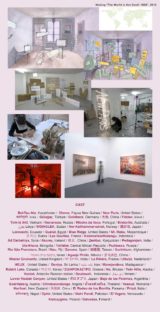The World Is Not Small–1826
2012, Gelatin silver print / Archrival pigment print on fiber base paper, Various sizes, 61 works
In this work, Yuki Onodera is once more exploring the theme of movement and embodiment. In her 2004 work, Roma-Roma, she selected two places named Roma, photographing scenes from the two localities, each in one lens of a stereo camera, thereby creating a richly allusive and elusive juxtaposition. In her 2006 Below Orpheus, she focused simultaneously on a missing person case on one side of the globe and a mythological tale that took at the precise antipode of the crime scene, bringing together two opposite ends of the Earth in her photographs. Clearly, the present work is an extension of this line of inquiry.
In this work, however, the artist, the camera, is not moving. Instead, she has assembled place names from around the globe, used them to create objects that resemble road signs, installing them in a brightly illuminated room with windows, and photographing them. In some of the scenes a road sign is placed so that it seems to point to an actual place, while in others several signs in different languages are grouped together. In still others, the room overflows with words representing place names, creating a kind of thriving forest of signs.
Glancing toward the window, one notices that the “place” the signs are pointing at does indeed exist, in the distance, beyond the bright, blank curtain of light.
Yuki Onodera’s focus on words and letters may be an expression of her questioning of the motifs of photography and painting. Now her interest is shifting to a new question—can writing succeed as the subject of photography?
Within the work, far distant places—frigid climes, tropical zones, deserts—are brought together into a single locus by the signs, which point off in different directions. Some of the place names incorporate topographical features—mountains, rivers, and valleys. They may include the names of the plants that grow there, the names of the people who live there, the names of other creatures unique to the place. The place names also suggest the culture and history of the places, their distinct features, and the subtle nuances attributed to the places by outsiders. Both the distinct character and externally imposed values of places are embodied visually through writing in various languages. In addition, the physical form of the signs, resembling a human figure with outstretched arms, anthropomorphizes them, transforming the room into a dramatic space. As we look at the signs, we find ourselves moving freely through space and dreaming of far distant places.
Today, with the Internet, we have instant access to pictures and images around the world, as if our world has been shrunk. By the same token, however, these easily available images have robbed us of our imaginative powers, and reduced the diverse features of other places into frozen icons. The artist’s skepticism about images, referred to earlier, is expressed through this work employing writing.
Reflecting on this work, Onodera harkens back to a time before the invention of photography:
Long ago, before I had photographs, I loved the names of distant places—the names of places east, west, north, and south. Simply by imagining what they must be like, I felt as if I were planning a great journey. The sounds of the place names and the letters with which they were written invited all kinds of fancies and daydreams. The more I imagined a place, the farther it seemed to draw away from me, and that unbridgeable distance was tremendously appealing. How big the world is, I thought. . . . Place names are distances, are space, are time, are nature, are history, are politics, are relationships. Where are we going? Where, in the end, can we go?
We are living in a flood of images, loaded into our minds at high speed. What we are in danger of losing is the much slower, more private, idiosyncratic time of imagining far-away places from their names alone.


















